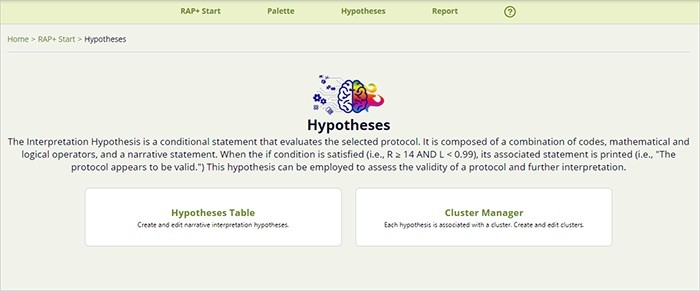|
<< Click to Display Table of Contents >> Interpretation Hypotheses |
  
|
|
<< Click to Display Table of Contents >> Interpretation Hypotheses |
  
|
For those seeking deeper exploration, the RAP+ offers a computational environment that replicates the process of formulating narrative interpretation hypotheses for Rorschach test results. The hypotheses table serves as the cornerstone of your interpretation routine. During report generation, the interpretation routine feeds the selected protocol values into each hypothesis. If a hypothesis is evaluated as true for the selected protocol, its corresponding statement text will be incorporated into the report. You can manage your interpretation routine through the Hypotheses table, where you can add, edit, or delete hypotheses. The RAP+ is multilingual, allowing you to write your narrative interpretation statements in the language of your choice.
Each interpretation hypothesis (IH) is affiliated with a cluster, which serves to organize these hypotheses. For instance, a Validity cluster could encompass several interpretation hypotheses pertaining to the protocol's validity. The cluster manager enables you to add, edit, or delete clusters. You can also control the presentation order of clusters within the report and the order of hypotheses within their respective clusters. Additionally, you can selectively include or exclude specific clusters or hypotheses from the report.
The hypothesis composer utilizes if statement to represent each interpretation hypothesis. For instance, the statement:
if "(R >= 17 and Rejection <= 1)", print: "The protocol appears to have a valid sample size."
(where 'R' is the number of responses and 'Rejection' is the number of rejected cards, both are standard RAP codes.)
The if statement conditional expression comprises a combination of Rorschach variables and mathematical or logical operators, adhering to the syntax conventions of computer programming languages. Yet, knowledge of computer programming is not a prerequisite for using this feature. The statement narrative section of the IH contains the text that will be displayed when the if condition evaluates to true for the selected protocol values. Consistent with other Virtual Psychology programs, RAP+ incorporates a built-in guiding system that provides helpful information as you interact with the program. In the context of IHs, the program offers an option to verify the syntax accuracy of the if condition. Furthermore, you can construct an if-else condition, whereby when the if condition evaluates to false, the else statement is printed in the report. In the example mentioned earlier, if the condition "if (R >=17 and Rejection <= 1)" is false, the 'else' statement "The protocol sample size is insufficient." will be displayed.

Once you created interpretation hypotheses, they are used with the reporting routine you can run on any Rorschach protocol in your Records Cabinet. This interpretation routine will pass the codes' values obtained for the selected protocol and compute them with the conditions you set in the if expression. If found to be true, the accompanying narrative interpretation statement will be printed in the report. In other words, when you generate a report the program passes the selected protocol values to the hypothesis condition expression and tests whether the condition is true or false. If true, the hypothesis statement will be printed out in the report. Else, if the expression is tested to be false, the program does nothing or prints the else-statement.